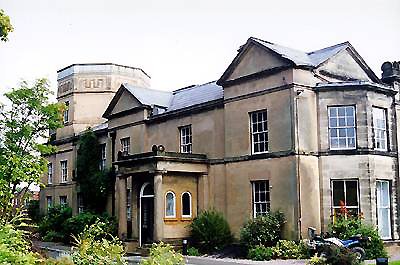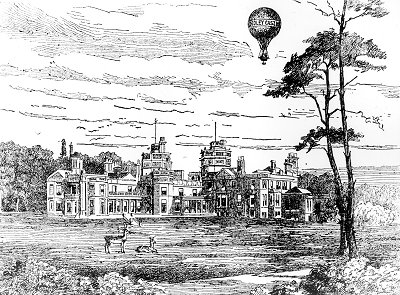|

Listing: c1770 but much altered c1820.
Large extensions of 1860s for Col. Thorneycroft and small C20
extensions. Col. Thorneycroft was interested in the
development of ventilation and heating and some of his innovations
are incorporated in the building.
Literature:
G.V.Hancock, History of Tettenhall College, Tettenhall College,
1963
Geoffrey Hancock, A Tettenhall History, Broadside, 1991 |
Comment: Although now an active and thriving school, the
place is still dominated by the spirit of Col. Thorneycroft - and the
Colonel was very spirited indeed. The listing expresses his
activities very mildly. Suffice it to say here that the interior
also contains, though somewhat reduced in size, the theatre installed by
the Colonel; and it it still in use. The tower shown in the
photo contains the large water tank which provided the waterfall at the
back of the stage; the water went from the waterfall to flush out the
drains. For the rest, Geoffrey Hancock's "A Tettenhall History"
provides delightful coverage.
The grounds contain much of interest, both in respect of buildings,
which are now clearly explained by historical plaques, and fauna and
flora, which are well covered by the School's nature walk.
But the development in the immediate vicinity of the old house has quite
devastated the setting of the garden side of the house. The
Colonel might not have been too pleased with this treatment of what he
fondly considered to be his country house park.
 |
This drawing by the local artist George Phoenix
shows the garden side of the Towers. The balloon,
named The Dudley Castle, was that in which the Colonel took a
somewhat hair-raising trip in 1882.
The event is splendidly
recorded in Geoffrey Hancock's A Tettenhall History, mentioned
above. The deer are doubtless two of those which the Colonel
kept as part of his country house park; but the land actually
available was too small, the deer persistently escaped and the
project had to be abandoned. |
He would have done better to
have followed the practice at Bantock House where highland cattle,
much beloved by the Victorians, decorated the ornamental farm. But the Colonel would try anything once. Or twice. Or
any number of times if he wasn't too busy on the next exciting
project.

|